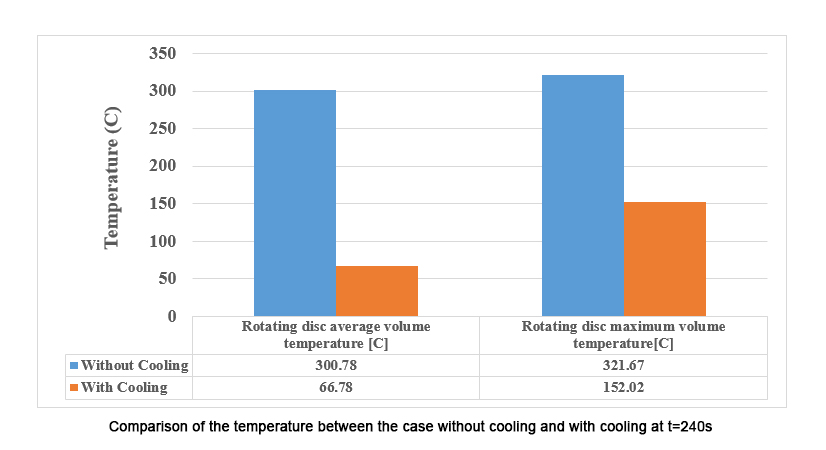OGAB® Rail Sustainable Braking
The patented Ogab® Sustainable Braking system offers increased safety levels, optimised brake performance, and significantly reduces the damaging environmental impact caused during braking on railways.

A reduction in average disc temperature of 22% with braking applied for just 62.5 seconds.
Ogab®‘s research programme carried out simulation tests on a standard UK passenger train.
In the test, our novel technology is developed and deployed to reduce the brake disc temperature during the function of braking and for three minutes after that.
By successful demonstration of such unique technology, it is possible to increase the maintenance requirement period and substantially extend the lifetime of the braking system’s consumable material (i.e. wearable brake pads) and reduce their adverse environmental effects. In addition, it can significantly increase the safety of the railway sector.
Our technology helps to;-
Reduce track fatigue
Give maximum safety and performance
Allow shorter stopping distances
Reduce fuel consumption
Prevent the maximum peak temperature of the brake being reached
Reduce track and brake disc buckling due to excessive temperatures
Offer greater reliability and reduced maintenance
Significantly reduce air pollution
Less CO2
Less NOx
All modern trains are equipped with brakes. Their proper functioning is relied upon for safe operation of trains on the rails. The brakes slow down the train and stop it in a reasonable amount of time.
On most trains, each of the main wheels is equipped with a brake unit. In the railway industry, the performance and efficiency of the brake systems are crucial for safety of passengers and those on the ground. Due to the very heavy weight of trains and low friction between the wheels and rails, the design of the brake system is very demanding.
Train brakes are often made of grey cast iron due to its desirable mechanical properties. The primary function of brakes is to convert the kinetic energy of the train into heat/thermal energy by creating friction. Therefore, a massive amount of heat is generated due to the enormous weight and velocity of trains. Due to this, the brake system components need to withstand a very harsh environment.
Since brake linings (stators or brake pads) are wearable, activating brakes cause significant material consumption on pads and environmentally harmful debris are released to the surroundings by each brake activation (which also increases the maintenance cost).
For the simulation test case with the proposed brake cooling technology, the system was activated onset of the braking function (brakes engaged), it remains active for the braking period (i.e. for 62.5 seconds) and then it remained operative for an additional 177.5 seconds (i.e. till t=240s) to achieve the effective cooling.
During this 240 seconds of transient simulation, the brake linings and the rotating disc were in contact only for the first 62.5 seconds (i.e. from t=0s to t=62.5s) and all the heat that was generated as the result of friction was released during this time. At t=62.5s till t=240s the brakes were released but the cooling system remained operative.
The qualitative and quantitative results of the brake system without cooling and with cooling are presented in this section. The results are compared at two time moments as t=62.5s (which is the end of the braking period) and at t=240s (which is the end of the simulation).
CFD Analysis - Without Cooling
CFD Analysis - With Cooling
As evident from the CFD Analysis above and the corresponding results charts below, deploying the cooling technology proved to be effective as it reduces the rotating disc average volume temperature from 374.25C to 292.85C (21.75% improvement) while the maximum disc volume temperature reduces from 450.47C to 405.28C (10.03% improvement) during the 62.5 seconds of braking.
The suggested cooling technology provided excellent results after 240 seconds as highlighted. With such technology it was possible to reduce the brake disc average volume temperature from 300.78C to 66.78C (77.79% improvement) while the maximum disc volume temperature reduces from 321.67C to 152.02C (52.74% improvement).
Results Chart with 62.5 seconds of braking and cooling active throughout this timeframe.

Results Chart with 62.5 seconds of braking and cooling active for a timeframe of 240 seconds.

It is evident from these figures that the cooling was beneficial in reducing the disc temperature at various time steps, with the temperature of the whole disc assembly being very low with the implementation of the cooling technology active for 240 seconds.
Our research has shown that the proposed cooling technology was very effective in reducing the rotating disc average temperature. It was demonstrated that with utilisation of such novel technique it is possible to reduce the disc average volume temperature by the maximum value of 21.75% after 62.5 seconds and by 77.79% after 240 seconds.
It should be noted that the proposed cooling technology was deployed to an existing brake system design. Therefore, its performance was limited by the nature of the current brake systems configuration. Considering the proposed cooling technology (which was proved to be very effective) during the design process of new brake system assemblies can enhance the cooling performance even further and provide more integrated configuration of brake system (i.e. embedded cooling with brake system).
Get the full facts and insight on the environmental impacts of the disc brakes product life cycle.
Ogab® can help make a change for the better. Contact us today to enquire about our Sustainable Braking technology and how it can help you.
